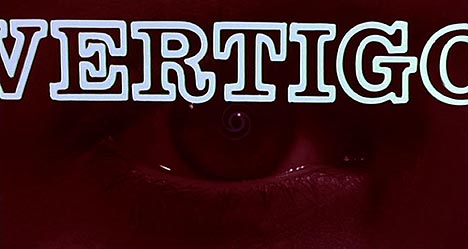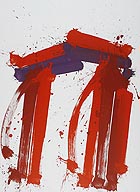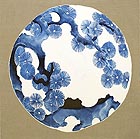
translated and summarized by: Liz Wollner-Grandville,
English summary March 23 - 29
KW Institute for Contemporary Art: Vorspannkino – 54 titles of an exhibition
Pure prelude
The Berlin Kunstwerke are attempting to add something new to the liaison cinema and museum: the opening credits, which has always been an essential part of a movie, oftentimes considered a necessary evil or annoying accessory.
Most introductions to a film attract the viewer’s attention right from the start: they transcend the limits of solely being an information medium and, combined with graphics, pictures and sound, they surpass their status of simply being a piece of commissioned work; they actually come across as an independent creation.
Saul Bass, who produced the opening to Hitchcock’s “Vertigo” (1958) and “Psycho” (1960), is one who escaped from his undeserved anonymity. With these two examples one could (insufficiently) categorize all of the 54 film titles presented at this exhibition. Most of them focus, in addition to the usage of overpowering symbolism, which points to what will follow, on the sensuous or the abstract. They claim one of the three elements – picture, sound, or graphics – as their leitmotiv or principle: you will find the eye playing an important role in Samuel Beckett’s “Film” (1965) or John Frankenheimer’s “Seconds” (1966), while the opening credits to Orson Welles’ “The Magnificent Amerbersons” (1942) and in Jean-Luc Godard’s “Le Mépris” (1963) are recited, and in Pier Paolo Pasolini’s “Uccellacci e uccellini (1966) they are sung. Graphics dominate Billy Wilder’s “The Seven Year Itch” (1955) and Norman Jewison’s “the Thomas Crown Affair” (1968) and again in Stephen Spielberg’s “Catch me if you can” (2002).
The random choice of films points to two aspects: the 60s were not only characterized by their readiness to try out new things in the field of fine arts, but it was primarily the (nearly extinct) species of an auteur who placed great value on an elaborate introduction to his film. It comes as no surprise that Quentin Tarantino put forth such great emotions in the production of his title sequences – thereby giving “Death Proof” (2007) a completely unintentional deeper meaning.
By Peter Kunitzky
KW Institute for Contemporary Art
10117 Berlin, Auguststrasse 69, until 19.04.09
www.kw-berlin.de
Galerie Ulysses: Markus Prachensky – Korsika Bepop
Prachensky remains Prachensky
Fascinating how this artist, born 1932, creates an extraordinary, distinctive painting with only a few “strokes” – which are more like thick lines. His works can currently be admired at the exhibition at the Gallery Ulysses. However, his typical style not only brings forth individual and wonderful compositions, but also numerous less notable works, which are still solid and a pleasure to behold, but not as compelling. Some of these works are also presented, positioned next to the grandiose central canvas hung in the main hall, and offering a logical framework.
His only work on paper, despite its small format, is very appealing: it proves that this artist, who is mainly known for his large canvas paintings, also masters the small, intimate format. All in all, this is a pleasurable, but not a groundbreaking exhibition. Prachensky remains Prachensky; even if one would at times wish that he would try out new things.
By Wolfgang Pichler
Galerie Ulysses
1010 Vienna, Opernring 21, until 30.04.09
www.kunstnet.at/ulysses
Kunstmuseum Bern: Tracey Emin – 20 Years
More than a bed
Who won the renowned Turner Prize in 1999? Well, although nominated, it wasn’t Tracey Emin. But in any case, from this moment on, the art world could not get enough of her – an artist from the Young British Artists (YBA) group, who displayed the most protected place of privacy with merciless openness: her bed. For an entire week she had lived, made love, and suffered: empty vodka bottles, full ashtrays, used condoms and tampons, underwear and dirty linen are the obvious proof. After awakening from this delirium and realizing that she could have died, she decided to present this microcosm of authenticity, the source of inspiration and essence of her art, her life, as a sculpture. And through her accessible and intelligible form of work, Tracey Enim became a star overnight.
After Edinburgh and Malaga, the Kunstmuseum Bern is now the third location presenting “Tracey Enim. 20 Years”. The exhibit proves that the works by the 45-year-old are by far more than products of a shock-effect calibrated narcissist. Her explicitly autobiographical work finds its roots in a wild life, narrates its story from a female perspective, and offers many quiet nuances, which are often accompanied by sad or angry undertones, without ever wanting to arouse pity.
During the 1990s, two traumatic abortions plunged the artist into a deep creative crisis. Killing a natural creation, a child, equalled the death of her creative centre, the source of her artistic expressiveness. The desire for a child and the unintended childlessness has become the focal point of her work. Bern offers the opportunity to experience contemporary art in its most intelligible and touching form.
By Sylvia Mutti
Kunstmuseum Bern
3000 Bern, Hodlerstrasse 12, until 14.06.09
www.kunstmuseumbern.ch
Winiarzyk: Karine Fauchard – Étude Pour un Intérieur
Outside in, inside out
The art show “Étude pour un Interieur” at the gallery Winiarzyk offers an interesting documentation about the assemblage of various materials forming a complete piece of work. This process is the essential question reflected in the French artist Karine Fauchard's creations. The outcome of this process, ranging from pencil sketches to opulent studies, was the creation of varying, cultural pieces of furniture. An interesting interaction between the different colour components evolves out of these simple and at the same time expressive paintings and drawings.
In this exhibit, the methodological progress of the interdisciplinary development of 25 objects is documented in great detail. The pigmentation and the mixing of chemical ingredients are mirrored in the recurring, manifold objects “untitled (bow)”, which conveys flowerlike spring- feelings. An enlarged ornament, reminding of classic Japanese porcelain painting, shows the complex relationship of the multiple levels of lacquer, glue, colour, and paper in great detail. The question about the composition of water (H2O) is answered analytically with the chemical formula and metaphysically with the depiction of the counter play of the added elements in diverse witty approaches.
Fauchard’s many years of work equal a humorous autopsy and the junction of the individual work stages evolve into a remarkable entity. Every single object addresses the link that associates it with the next, but it can, and is, always regarded as an individual object. This is the strength of the composition.
By Alexander Lass
Winiarzyk
1020 Vienna, Praterstrasse 13, until 11.04.09
www.winiarzyk.com
Mehr Texte von translated and summarized by: Liz Wollner-Grandville


 Teilen
Teilen





